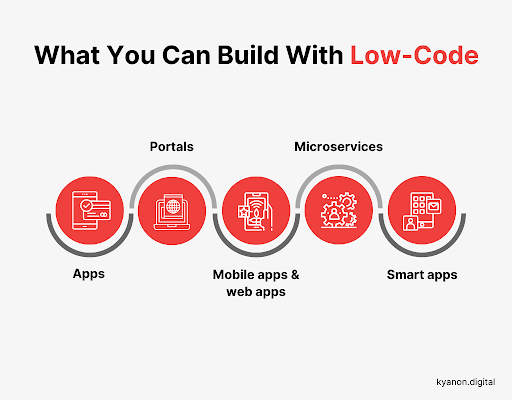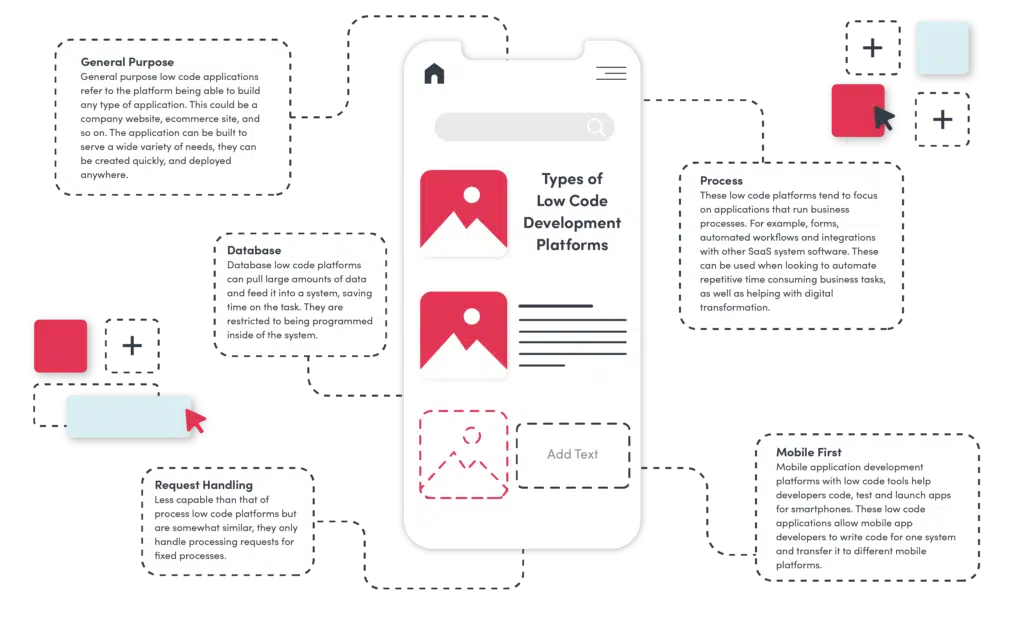Best Suggestions To Selecting application development with Low-code platforms
The Advantages Of Low-Code Development For Developing Applications As It Is Related To Integration CapabilitiesLow-code apps offer a lot of benefits in terms of integration, which is vital when developing applications that are able to seamlessly connect different systems and services. Here are a few major advantages: pre-built connectors and APIs.
A Wide Variety of Connectors Low-code platforms generally come with a vast library of connectors that are pre-built for the most popular enterprise software (e.g. CRM, ERP and cloud services such as databases,). This makes it easier to integrate with systems.
API Integration: Many Low-Code platforms include out-of box API integration tools that allow developers to quickly connect external services and data resources.
Easy of use:
Drag-and-Drop Integration integration tasks can usually be accomplished using drag-and-drop interfaces, making it possible for both developers and non-developers to design complicated integrations without writing a lot of code.
Visual Workflow Designers: These software tools assist you in understanding and implementing integrations with more ease.
Standardized Integration Methods:
SOAP and restful services: Supporting web-based services common protocols such as REST or SOAP makes integration easy with many different software and systems.
OData Standards: OData standards allow for the easy manipulation and retrieval of data across various platforms and applications.
Real-Time Data Synchronization:
Real-Time Integrations: Low-code platforms are able to handle real-time synchronization between data systems, applications as well as databases. This will ensure that data is up-to-date and consistent throughout an company.
Event-Driven architecture: Certain platforms can support event-driven architectures. This lets applications respond to events in real time and is crucial for dynamic and interactive apps.
Legacy System Integration:
Bridging old Systems and New Systems Low-code platforms often provide tools to integrate with existing older systems. This allows organizations to upgrade their IT Infrastructure without having to overhaul the current systems.
Data Migration Tools Built-in data migration tools make it easy to transfer data from older systems to applications that use low-code.
Integration of Third-Party Services:
Cloud Services: Integration with cloud services including AWS Azure and Google Cloud allows easy deployment and scaling.
Integration of Business Applications: Lowcode platforms can be utilized to connect various business applications like Salesforce, SAP, Microsoft Dynamics etc., creating a cohesive workflow among different business functions.
Simplified Data Processing
Unified Data Models: A few lowcode platforms offer unification of coding models that simplify managing data as well as integration and synchronization between various systems.
Data connectors: Data connectors that are preconfigured to give easy access and control to data from a variety of sources.
Security and compliance:
Secure Integrations: Low-code platforms ensure that integrations conform to security protocols and standard, protecting data during transport as well as at rest.
Security Features: These platform often include features which assure that integrations are in compliance with regulatory requirements, such as GDPR or HIPAA. This can provide peace ofmind for businesses handling sensitive data.
Extensibility:
Low-code platforms can often accommodate complex integration needs by including custom code or scripts. They provide flexibility, without compromising the ease of use.
Plug-in Ecosystems: An eco system of plugins and extensions lets users expand their integration capabilities. They can add new features when they require.
Low-code platforms provide a powerful device to build interconnected, robust and scalable applications. These platforms streamline the process of connecting different IT systems, improve the flow of data, and aid companies adopt technologies that are already in use, and also make use of new ones. Follow the best Low-code Platform for application development recommendations for site recommendations including cross platform app dev, sso azure, rapid app development, azure sql server, lowcode no code, cloud software applications, jdbc server, push alerts, push alerts, multiplatform mobile app development and more.

Benefits Of Developing Applications Using Low-Code In Terms Of Cost-Efficiency
The low-code method of application development is an affordable solution that has many benefits. It's a great option for companies who want to make the most of their budgets as well as create quality apps. Here are some of the main advantages:
A lower code platform makes it less necessary to write long manual code. This saves time and effort on the part of developers in developing applications. This results in less labor costs.
Fewer Developers: Because low-code development is quicker and more simple to develop, there are less specialized resources for developers required. It could reduce the costs of staffing and hiring.
More rapid time to market
Accelerated Development Cycle: Visual tools for low-code platforms and components allow for rapid application creation, which allows businesses to launch new products quicker. This could lead to more rapid growth in revenue and enhance the competitive position of their products.
Rapid Prototyping. Businesses can quickly test and create prototypes. This helps reduce time during the development phase, and permits quicker iterations built on feedback from users.
Lower Maintenance Costs
The modular architecture and standardized components of applications built on low-code platforms makes them simpler to maintain. This means that they are less likely to require ongoing maintenance and support cost.
Automated Updates: Many low-code platforms handle patches and updates in a way that is automatic and ensure that applications are secure and up-to-date, without the need for lengthy manual intervention.
Efficient Resource Utilization:
Contributions from Non-Developers Low-code platforms allow business users and non-developers alike to be part of the development process. This decentralization of development processes allows companies to tap into the expertise and expertise of a greater number of employees.
Improved Utilization of IT Resources: IT departments can focus on more strategic initiatives instead of getting bogged down by routine tasks of development which can increase overall productivity and efficiency.
The Scalable Pricing models
Subscription-Based Pricing: Many low-code platforms provide flexible, subscription-based pricing models that scale with use. This lets businesses align their spending with their actual needs and increase their revenue, without incurring large initial expenses.
Pay-As You-Go: Some platforms allow pay-as-you-go. This lets companies only pay for resources that they actually use. This is particularly beneficial for small and new businesses with a limited budget.
Reduced Third-Party Software costs:
Low-code platforms typically come with integrated functions that eliminate the need to purchase extra software or tools. This could save you cash on subscriptions and licensing fees.
Pre-Built Integrations: The availability of pre-built integrations with popular systems and services reduces the requirement for custom development, thereby saving time and money.
Improved ROI:
More efficient return on investment The combination of rapid development, less expensive and a faster time to market, means that businesses can achieve a faster ROI (ROI) on their applications.
Improved Agility - Businesses can quickly adapt to changes in market and the changing needs of customers. This lets them stay current and take advantage of opportunities that arise.
Train for More for
User-Friendly Interfaces: The nimble, user-friendly interfaces of low-code platforms can reduce the learning curve for novice users, and reduce the need for lengthy training programs.
Accessible Resources Low-Code Platforms: Many low-code platforms have comprehensive training materials, tutorials, as well as community support, reducing the requirement for formal education and the associated expenses.
Streamlined Collaboration:
Enhanced Collaboration Tool: The built-in collaboration tool helps improve collaboration and communication among team members. This leads to better development processes and also reduces the cost of projects.
Unified Development Environment. A single integrated software development environment can streamline processes and reduce the complexity and cost of managing multiple platforms and tools.
The overall cost-effectiveness of low-code software development can be attributed to its capacity to lower the cost of maintenance and development as well as increase the time to market and optimize the use of resources and also provide flexible pricing models. Low-code offers substantial financial advantages to businesses. Have a look at the top rated https://www.wavemaker.com/application-modernization/ for website recommendations including azure sql databases, cross platform mobile dev, lowcode no code, paas service, application modernization, jdbc server, paas service, app dev platform, software for app development, push alerts and more.

Benefits Of Low-Code Application Development In Terms Of Specifications And Customization
Low-code application development is a balanced solution that has significant advantages in dealing with limitations and permitting customization. Here are a few of the main benefits:Handling limitations:
Removing Complexity Barriers
Low-code development platforms are easy to use due to the fact that they come with ready-made components, templates, and other tools. They also facilitate faster deployment of complicated applications.
Many platforms have guided workflows, which assist developers navigate their way through the complex procedures. They minimize the risk of error and maintain uniformity.
Scalability Solutions
Scalability is a part of the Low-code platform often includes features that allow for an architecture that is scalable. Applications can handle increasing demands with little redevelopment.
Performance Monitoring: Instruments for monitoring and enhancing performance are built into the application to ensure it remains efficient regardless of how it expands.
Security and Compliance
Security features integrated into Low-code platform comes with built-in measures of security such as encryption. Role-based access control and automated compliance check to address the most prevalent security concerns.
Platforms frequently update their compliance and security measures to ensure that applications are safe from new threats.
Customization Options:
Extensibility:
Low-code platforms allow developers to extend functionality beyond standard offerings by adding customized code.
Customized plugins and modules: Developers can create custom plugins or modules to provide specific features that are adapted to unique business requirements.
APIs and integration
API Support: A comprehensive support for APIs facilitates seamless integration with external systems and services, allowing for extensive customization and connectivity.
Third-Party services: Low-code platforms provide connectors that are built for popular third party services. This makes it easier to modify and integrate apps.
Flexible design of UI/UX:
Customizable Interfaces: Developers have the ability to design and modify user interfaces according to specific branding and usability requirements and create a personalized user experience.
Responsive Designs: The applications can be adapted to fit various screen sizes and devices.
Customizing Business Logic is easy:
Visual Workflow builders They allow developers to develop complex processes using little or no programming. They are able to design workflows and business logic visually.
Conditional Logic and Scripting : Platforms support conditional logic as well as custom scripting to deal with specific business rules.
Data Management:
Custom Data models: Developers have the ability to create custom data models to satisfy specific requirements of an application and make sure that data handling meets business needs.
Advanced Data Processor: The combination of sophisticated data processing tools and capabilities allows for the customisation of the method by which data is processed and used within the application.
Balance Customization and Limitations:
Frameworks and Standards
Low-code platforms conform to the industry standard and best practices. This helps maintain the highest quality and security of applications.
Governance Frameworks. The built-in governance frameworks ensure that customizations will not compromise the security, compliance or the integrity of the application.
Iterative Development:
Rapid Prototyping. Developers can develop and modify applications based on user feedback.
Low-code platforms allow for continuous improvement by allowing the continuous improvement of their design and enhancements the platform as requirements of business evolve.
User Empowerment
Giving Citizen developers the tools they need: The low-code platform's intuitive interfaces allow non-developers create customisations. This boosts the number of people who can contribute to enhance and modify applications.
Training and support: Many platforms offer extensive training materials and support services to assist users in making modifications which are efficient without compromising the application's performance or stability.
Overall, low-code application development provides a solid system for dealing with limitations, and offers a wide range of possibilities to personalize. This allows companies to build and maintain apps that function and adapted to specific business needs. While maintaining high quality, security as well as scalability and standards.
